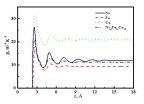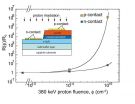(Press-News.org) An article published in the Health Affairs December issue is the first ever comprehensive analysis to investigate the Affordable Care Act's (ACA) Essential Health Benefit (EHB) as it relates to children. The study found that the EHB has resulted in a state-by-state patchwork of coverage for children and adolescents that has significant exclusions, particularly for children with developmental disabilities and other special health care needs.
Previous studies have compared the EHB standard more broadly to the Children's Health Insurance Program (CHIP), but this analysis presents the detailed evidence regarding the types of exclusionary practices that limit the effectiveness of coverage for children insured through health plans sold in the individual and small group markets. The analysis was conducted by researchers from PolicyLab at The Children's Hospital of Philadelphia; Children's National Health System in Washington, DC; Johns Hopkins Bayview Medical Center; and the Milken Institute School of Public Health at the George Washington University (GW).
"The Affordable Care Act offers great promise for kids, but we are concerned that its intended benefits are not fully realized for children. We sought to understand which pediatric services are covered, and which ones are excluded, by health insurance plans in the health insurance Marketplaces. Since there is currently no national pediatric benefit standard, our analysis compared benchmark plans at the state-by-state level," said study lead author, Dr. Aimee M. Grace, a pediatrician and fellow at Children's National Health System.
"Pediatric services" is one of ten benefit classes required by the ACA that must be covered in all health insurance plans sold in the individual and small-group health insurance Marketplaces. However, other than oral health and vision care, neither the ACA nor the regulations for implementing it define "pediatric services". Additionally, while the ACA gave the Health and Human Services (HHS) Secretary the ability to define a pediatric benefit standard at the national level, HHS chose instead a state-by-state benchmark plan approach, which affords greater discretion to both states and payers. The researchers found that this approach has led to great variation among states regarding coverage of pediatric services. For example, 25 states specifically cover treatments for congenital defects, and 24 specifically include coverage for both autism spectrum disorder (at least in part) and hearing aids. There is also great variation among states regarding exclusion of certain pediatric services; for example, 13 states specifically exclude services for children with learning disabilities, and 10 states exclude speech therapy for developmental delays, stuttering, or both.
According to senior author Sara Rosenbaum, the Harold and Jane Hirsh Professor of Health Law and Policy and Founding Chair of the Department of Health Policy at the Milken Institute School of Public Health at GW, "This benefit patchwork means significant state-to-state variation in what will be covered for children with special needs."
The analysis suggests four potential policy steps:
1. Pediatric treatment limits and exclusions, particularly exclusions based on mental retardation, mental disability, or other developmental conditions, should be barred.
2. The concept of "medical necessity" should be incorporated into the defined pediatric benefit. Medical necessity should include not only the clinical utility and appropriateness of a covered service, but also whether the service is appropriate in the pediatric developmental health context.
3. The essential health benefits standard for pediatric services should be revised to address both covered services, particularly for children with special needs, and actuarial value (the percentage that the average person can expect the plan to cover). The authors suggest keeping with the current CHIP practice of an actuarial value of 90 percent for qualified health plans sold in the Marketplaces, to reduce the burden of high deductibles, coinsurance, and other forms of cost sharing for families with children.
4. The use of CHIP plans as a benchmark plan for pediatric services should be permitted.
HHS made a commitment to review its "benchmark plan" approach for the 2016 plan year. At this time, HHS could define a pediatric benefit standard at the national level. Establishing a benefit standard has important implications for the eight million children who currently receive their health insurance coverage through CHIP, a program whose funding has not been extended beyond 2015. If this funding were not extended, many of these children would enter the Marketplaces for their insurance coverage. For these children, as well as the children already covered by plans in the Marketplaces, the appropriateness of the essential health benefits standard for children is one of the most important issues in child health policy today.
As noted by Kathleen Noonan, a co-author, and Co-Director at PolicyLab at the Children's Hospital of Philadelphia and faculty at the University of Pennsylvania's Master of Public Health Program, "With Congressional debate expected about whether to extend funding for CHIP beyond fiscal year 2015, how well the pediatric services element of the essential health benefits standard addresses the needs of children will be an important factor to consider."
INFORMATION:
The study abstract is available online at: http://content.healthaffairs.org/content/33/12/2136.abstract. The full article is available upon request.
Aimee M. Grace, the report's lead author, will speak about the report's findings at a press conference December 8 at the National Press Club. Find more information here: http://healthaffairs.org/blog/2014/11/24/health-affairs-december-briefing-childrens-health/
About The Children's Hospital of Philadelphia
The Children's Hospital of Philadelphia was founded in 1855 as the nation's first pediatric hospital. Through its long-standing commitment to providing exceptional patient care, training new generations of pediatric healthcare professionals and pioneering major research initiatives, Children's Hospital has fostered many discoveries that have benefited children worldwide. Its pediatric research program is among the largest in the country. In addition, its unique family-centered care and public service programs have brought the 535-bed hospital recognition as a leading advocate for children and adolescents. For more information, visit http://www.chop.edu.
WEST LAFAYETTE, IN/ITHACA, NY - Energy costs account for one of the largest expenses in commercial greenhouse production of annual bedding plants. Naturally, bedding plant producers are searching for more energy-efficient production methods that can reduce fuel usage and increase profits. Christopher Currey, Roberto Lopez, and Neil Mattson published a study in HortTechnology that gives growers in northern latitudes valuable information on finishing practices for annual bedding plants. The researchers compared traditional heated greenhouses with unheated high tunnels for ...
(SAN FRANCISCO, December 6, 2014) - New treatment combinations and targeted therapies for lymphoma and multiple myeloma are improving outcomes for vulnerable patient populations with hard-to-treat disease, according to studies presented today at the 56th American Society of Hematology (ASH) Annual Meeting and Exposition.
Despite advances in lymphoma treatments, improving the prognosis for patients with relapsed and treatment-resistant disease remains a challenge. The early success of several precision therapies associated with fewer side effects than conventional approaches ...
(SAN FRANCISCO, December 7, 2014) - Studies presented at the 56th American Society of Hematology (ASH) Annual Meeting and Exposition compare new and standard-of-care treatments for blood clots and further illuminate clot risks in vulnerable populations, such as cancer patients.
Although significant advances have been made in the treatment and prevention of blood clots through new and improved therapies for clotting disorders, challenges remain in balancing the benefits and risks of these therapies. Specifically, while these treatments can reduce patients' risk of suffering ...
It is estimated that about 35 million people worldwide currently suffer from dementia and it is expected that the number will increase to 135 million by the year 2050. The disease is already one of the most common health problems in the elderly, which is why experts predict that the numbers of people affected will increase over time. Researchers at the Department of Psychiatry and Psychotherapy of the University Medical Center of Johannes Gutenberg University Mainz (JGU) have recently gained new insights into how it may in future be possible to treat patients with the currently ...
The ability to predict macroscopic physical and chemical properties from information derived at the micro-scale or atomic scale for various kinds of materials has yet to be perfected in the field of materials physics and chemistry. Although macro-scopic properties are determined by the micro or atomic structure of materials, it is still difficult to obtain such properties as hardness, intensity, surface tension, density, thermal expansion, thermal diffusion, viscosity and specific heat from a cell with just several atoms because of multi-scale effects.
For solids, particularly ...
Gallium nitride (GaN) based devices are attractive for harsh environment electronics because of their high chemical and the mechanical stability of GaN itself that has a higher atomic displacement energy than other semiconductor materials.
However, degradation mechanisms of GaN device under radiation environments is not clear mainly because devices consist of many different types of semiconductors, such as p-type and n-type layers in light emitting diode (LED), and each layer has different hardness to radiation.
Now, researchers at the Electronics-Inspired Interdisciplinary ...
Macrophages are best known for their Pac Man-like ability to gobble up cellular debris and pathogens in order to thwart infection. A new study in The Journal of Cell Biology describes how these immune cells also help resolve inflammation by inducing white blood cells called neutrophils to leave wounded tissue.
Neutrophils are "first responders" that are attracted to wounds by signaling molecules called reactive oxygen species (ROS) that activate a protein kinase. When neutrophils finish their work, inflammation is partly resolved through apoptosis, or cell suicide, and ...
What does it mean for expectant mothers and hospitals when there are large-scale closures of maternity units? A new study led by researchers at The Children's Hospital of Philadelphia provides an inside view from hospital staff members in Philadelphia, where 13 out of 19 obstetric units closed in a 15-year period.
The researchers found that sharp surges in patient volume in the remaining units strained the healthcare system, eroded workforce morale, and fragmented care for mothers and babies until hospitals adjusted to added demands.
"While the degree of obstetric ...
WASHINGTON, DC (December 8, 2014)-- Despite the promise of health reform, millions of U.S. children still lack quality health coverage or have trouble getting the services they need to stay healthy or to develop properly, according to two articles published in the December issue of Health Affairs. To address these gaps in coverage, broad reforms aimed at improving the quality of coverage for all children are needed, according to the authors.
In the first article, Sara Rosenbaum, JD, the Harold and Jane Hirsh Professor of Health Law and Policy at Milken Institute School ...
WASHINGTON, DC - December 9, 2014 - Seasonal flu vaccines may protect individuals not only against the strains of flu they contain but also against many additional types, according to a study published this week in mBio®, the online open-access journal of the American Society for Microbiology.
The work, directed by researchers at St. Jude Children's Research Hospital in Memphis, Tenn., found that some study participants who reported receiving flu vaccines had a strong immune response not only against the seasonal H3N2 flu strain from 2010, when blood samples were ...




